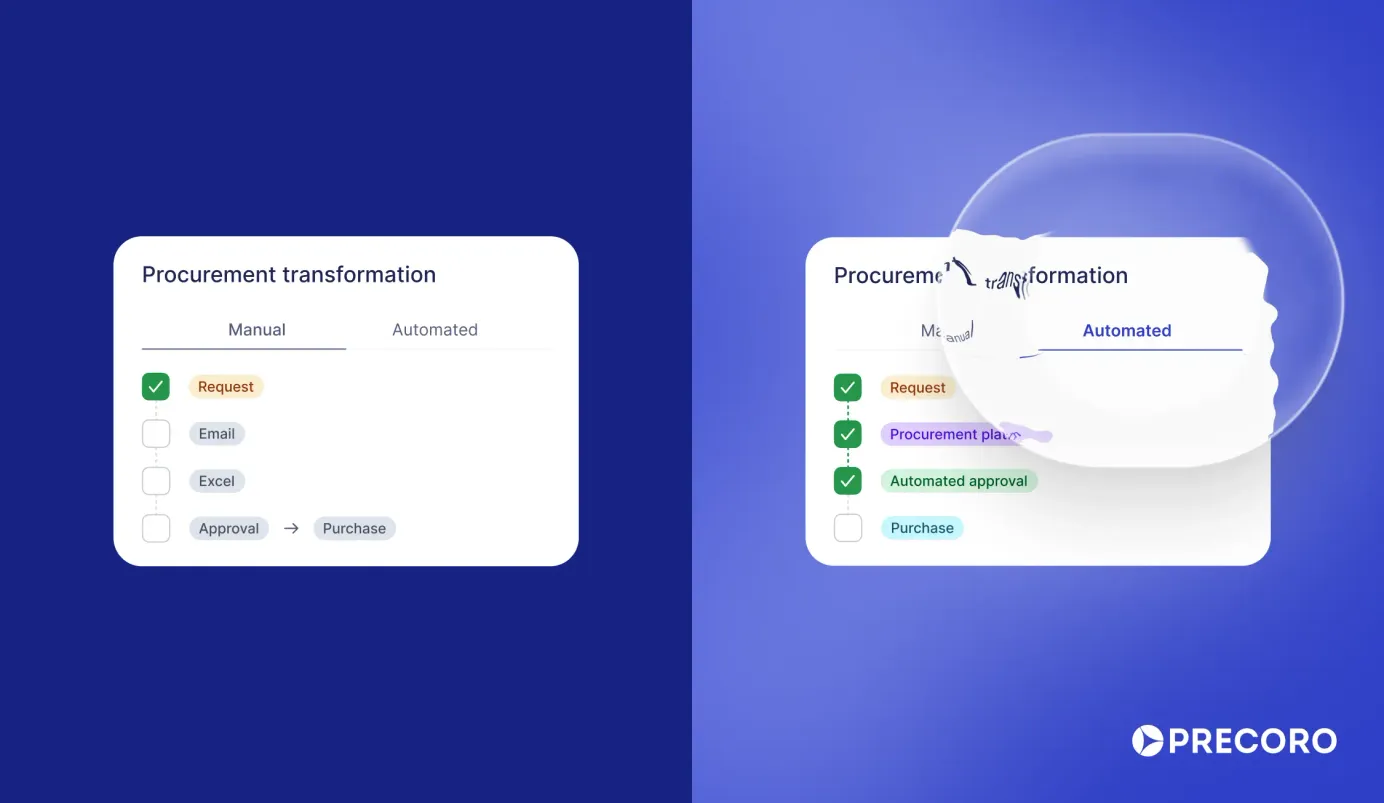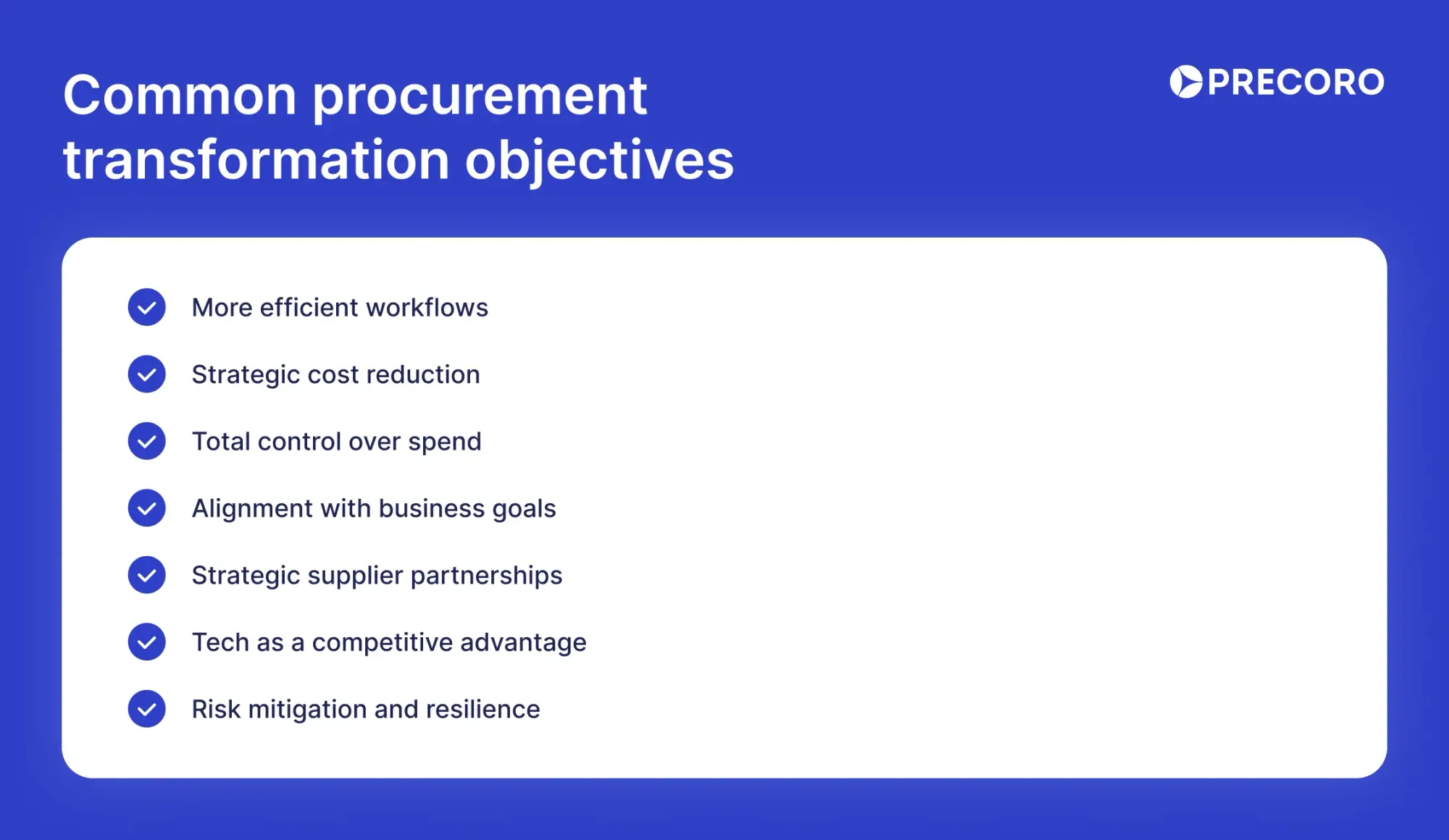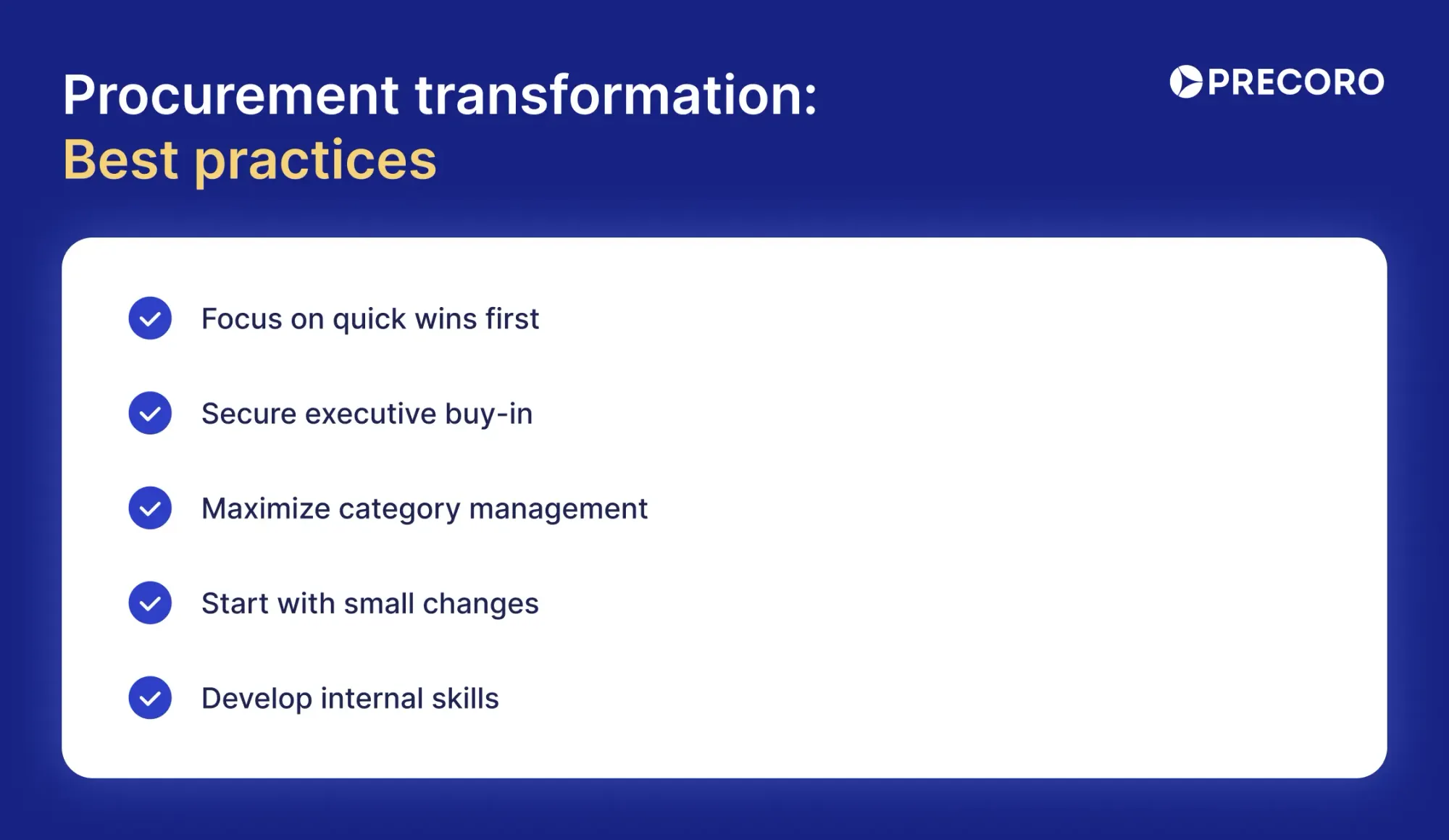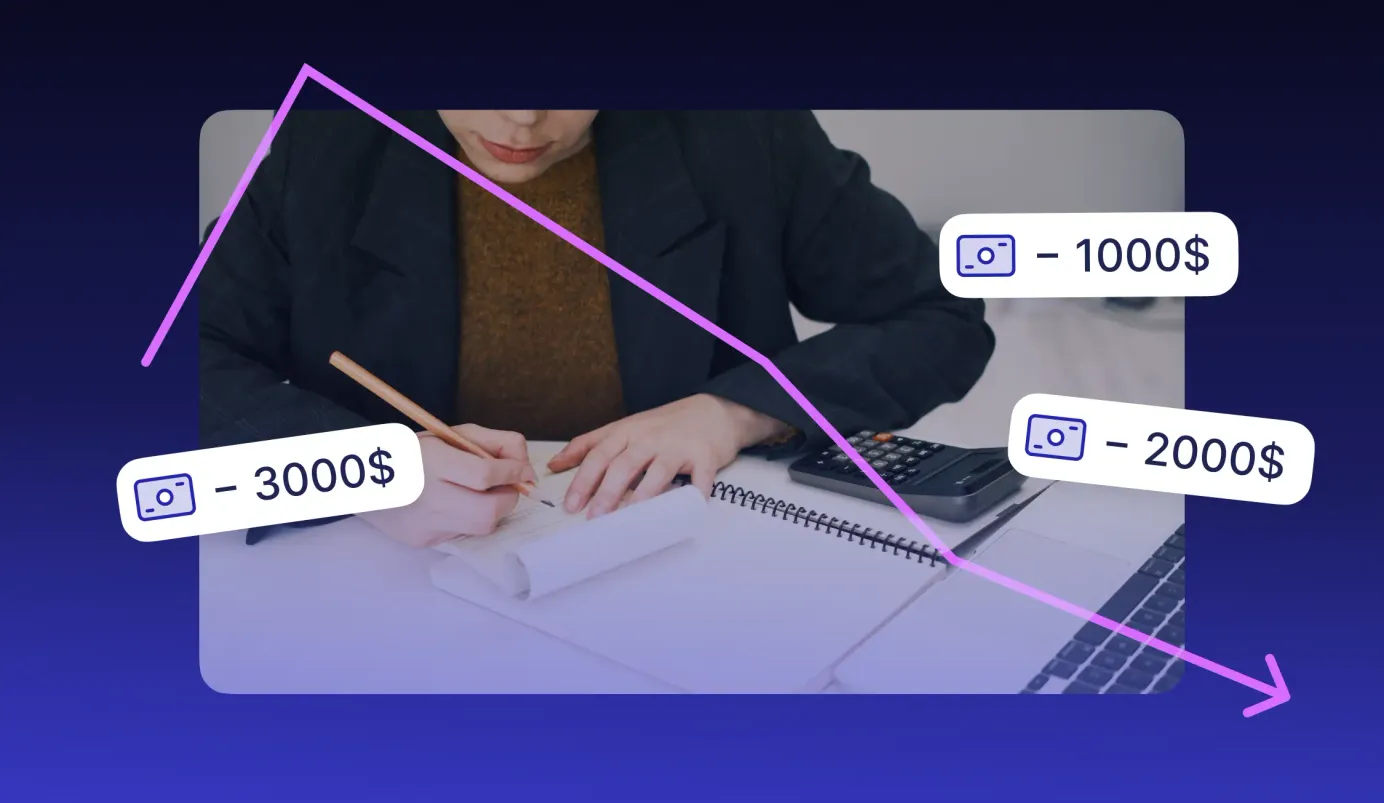
17 min read
Procurement Transformation Guide: Best Practices and Roadmap Steps
Learn why procurement transformation can be a strategic game-changer, even for businesses with systems that work “just fine.”
Procurement teams know that change is long overdue. It’s time to put manual processes and Excel spreadsheets behind us and think of smarter, more efficient ways to purchase. Sticking to the same old ways feels safe, but it holds your company back.
While you still manage procurement the traditional way, nearly 4 in 10 procurement leaders name digital procurement transformation their biggest challenge in 2025. Their goal is to automate time-consuming tasks, save both money and time, and ensure compliance across the board. And it’s no surprise: a switch to e-procurement solutions can cut purchasing processing time by 50%.
To guide you through the transition, we’ve compiled an article on what procurement transformation is, what companies need it, and its benefits and challenges. Additionally, we outlined procurement transformation best practices and the key steps in building a comprehensive roadmap.
Scroll down for more insights on:
What is procurement transformation?
What do companies want to achieve with procurement transformation?
Signs your company needs to transform procurement
Common blockers to procurement transformation
How to build a procurement transformation strategy?
Procurement transformation: Best practices
Frequently asked questions
Why Precoro is the right choice for digital procurement transformation
What is procurement transformation?
Procurement transformation refers to the process of reorganizing and modernizing the way an organization purchases goods and services. Often, it means moving away from traditional procurement methods like ad-hoc purchases without a big-picture view to strategic, technology-powered approaches.
Digital procurement transformation is at the heart of it: more and more organizations choose to automate how they purchase and hand over time-consuming tasks to AI.
What do companies want to achieve with procurement transformation?
Procurement used to be mainly about reducing costs and handling purchases. Now, however, it’s expected to play a bigger, more strategic role. CPOs aren’t just asking, “How do we budget our purchases for this quarter?” They’re asking, “How do we make the most out of every purchase and vendor relationship?”
Here’s what companies can achieve through procurement transformation:
More efficient workflows
Traditional purchasing is often riddled with slow steps: waiting on approvals, looking for missed documents, and double-checking what’s already been ordered. When that’s the norm, it can delay entire projects. Once you decide to completely overhaul procurement and implement an automated solution, the procurement cycle will shorten and leave your team with enough time to focus on tasks that actually bring value.
Strategic cost reduction
Cost reduction always matters—after all, a third of executives list slashing costs as their main priority for 2025. Procurement transformation changes what kind of savings you get from cutting expenses. Instead of being temporary and not impactful, a smart procurement strategy ensures sustainable and steady savings that can be reinvested into your company’s growth. It reveals exactly where your money goes, highlights opportunities to combine orders, and equips you with tools to negotiate better deals.
Total control over spend
Rather than plan ahead, traditional procurement often operates on ad-hoc purchases or orders needed “by tomorrow.” This reactive approach makes it hard to see the bigger picture and leads to numerous maverick purchases and zero control over spending.
Additionally, when procurement is decentralized, meaning that each business unit, department, or location handles purchasing on its own, you lose sight of what exactly is being bought, what was approved, and whether budgets were even followed. Transforming procurement both with digital tools and an overhaul of procurement policies can help bring all expenses into focus.
Alignment with company goals
Procurement cannot operate in a silo, isolated from other company functions. In a well-developed procurement transformation strategy, transactions have to support the bigger company goals, not just financial ones. For instance, good procurement habits can form a financial baseline for the launch of new products or support the company’s sustainability goals. They work in sync with other areas, not outside of them.
Strategic supplier partnerships
When vendor relationships don’t grow with the business, they start holding the company back. If you don’t make an effort to make vendor relations more strategic, you’ll lose out on better deals from negotiations, early access to materials, and priority delivery.
Sourcing transformation often involves expanding the supplier network to make your supply chain more dependable. Some companies choose to “friend-shore” (source primarily from countries that are geopolitical allies) amid tariff and trade law uncertainties. Others work on building deeper relationships with existing suppliers through vendor scorecards and SRM systems.
Technology as a competitive advantage
The word “digital” in procurement transformation is no longer a buzzword but a reality for how businesses operate. Companies want to keep up with technological advances. They see the potential in using newer tech and AI to propel their procurement process forward. CPOs are moving away from Excel or, worse, printed paperwork and are replacing them with procurement platforms that speed up approvals, automate invoice management, and centralize all documents in one clear audit trail.
Procurement gets more digital with every step, with 96% of companies having a P2P solution. You kill two birds with one stone: the processes are more transparent and efficient, while your company remains on equal footing or even ahead of the competition, thanks to high-tech procurement transformation.

Risk mitigation and resilience
Supply chain disruptions, inflation, and shifting regulations are part of business life. They’re avoidable but not completely preventable. A procurement system that stays in the past has no leverage against the market's ever-changing conditions.
On the other hand, digital procurement transformation helps you mitigate those risks and build a cushion to fall back on once they arise. For example, switching from single sourcing to multiple suppliers helps you avoid potential stockouts or emergency situations that can happen if the single supplier fails.

Signs your company needs to transform procurement
A lot of organizations stick to the same old system for years without changing anything. Often, employees resist changes and claim that the current setup works just fine. However, even if everything seems to be working in sync on the surface, look out for these signs that indicate that you probably should change things up:
- Routine tasks take too long. If something as simple as approving a PO or an invoice takes hours instead of minutes, it’s time to make some changes. Delays happen for a number of reasons. Some processes are overcomplicated and could use a bit of simplicity. Maybe you can’t get a hold of approvers or aren’t sure who is responsible for the task. Whatever the case, if processes stall, it’s time for a change.
- Teams struggle to define what they need. As the company scales and the market evolves, the teams need to adapt their processes and change what they purchase. For example, executives want to invest in cloud-based collaboration tools to support a growing remote workforce. However, the team has no idea which vendor offers the best long-term value and picks based on a flashy demo and overspends on features they’ll never use.
- You don’t see a bigger picture across business entities. In larger organizations, different branches may have entirely separate procurement structures, often completely isolated from each other. Although fragmented purchasing seems easier to handle, it makes understanding what’s happening company-wide nearly impossible. And it’s not just about branches: if procurement has limited access to AP data, they may miss some transactions and fail to account for them in the future.
- Demand outweighs employee capacity. If procurement struggles to keep up with purchase requisitions and purchase orders, the current system isn’t working. Purchases are made more slowly, and employees quit because they’re burned out, which means you waste even more time hiring and onboarding new employees.
- Budgets are often overrun by off-contract purchases. If a track record of employees purchasing from unapproved vendors keeps rising, it’s time to rethink your purchasing policies. Maybe they’re too complex to navigate, unclear, or not enforced enough. Whatever the case, you need to take action. Rogue spending is often the main reason why companies fail to meet their yearly savings goal and revenue targets.
- You use a one-size-fits-all system that doesn’t satisfy anyone. Different types of purchases require different workflows. What works for software contracts won’t work for utilities, subscriptions, or urgent travel. Forcing everything through the same process only slows teams down. A better system takes every type of purchase into account and has different policies for different transactions.
Common blockers to procurement transformation
Even the best procurement transformation strategy can hit a wall if you don’t address the main roadblocks early on. Often not visible from the get-go, they can slowly creep in and stall the transformation process or even ruin it altogether. Before tearing down your current procurement process, address these limitations first:
- Internal resistance.
When teams have been doing the work the same way for years, the smallest changes can either feel like extra work or a step backward. Some employees don’t trust the leadership due to previous broken promises or misaligned expectations. Others are simply afraid of changes and of losing control over the process once familiar steps are replaced by new ones. - No higher-up alignment.
If leadership isn’t aligned on what procurement transformation should achieve, priorities can clash. For instance, if finance mainly wants to achieve more savings, while operations need all procurement paperwork to go through as quickly as possible, procurement may be caught between them. - Lack of skills and training.
New tools mean new onboarding and staff training. You can’t expect teams to adapt to new tools or workflows without giving them time to learn. Transformation is doomed to fail when people are undertrained, overwhelmed, or don’t have sufficient skills. - Unrealistic timelines.
Procurement transformation is a complete overhaul of systematic processes, which means doing it right takes time. Be prepared to dedicate 1–3 years of the company’s time to successfully implement the transformation program. Don’t pull the plug on the strategy if you don’t see results in a few months. Some benefits can only be seen at a year-end close once you analyze the bigger picture. - Poor supplier communication.
Vendors can’t deliver what they don’t understand. When the company doesn't clearly share its goals and changes to the procurement process, especially those that affect suppliers, vendor performance and engagement will suffer. - Outdated technology.
Companies that still use slow and clunky legacy tools need to consider which new ones can smoothly connect to the rest of the systems. Implementing a new tool is costly on its own, and the workload doubles if it can’t automate key processes or sync with existing software. For example, if your new procurement platform doesn’t connect with your ERP system, someone ends up re-entering the same data manually every time. - Hyperfixation on one objective.
Most procurement functions are tracked against four metrics: compliance, speed, quality, and cost. Organizations that are laser-focused on one of these metrics instead of paying equal attention to all of them can miss blind spots in other areas. Let’s say the company wants to speed up its PO processing and decides to simplify the approval workflow to two steps instead of four. Suppliers receive the POs quicker, but compliance suffers, and you end up with maverick purchases and unclear item specs.
How to build a procurement transformation strategy?
Turning procurement into a strategic asset takes a clear plan and commitment from everyone involved, from procurement managers to the CEO. Questions like “Who’s responsible?”, “What’s our goal?” and “Why do we need this?” should be answered well before the first changes happen.
After all, it’s a complete overhaul of a function that can impact more than 20% of the company’s spending. If you’re not sure where to start, here’s a step-by-step guide on how to make a procurement transformation strategy work in practice, not just on paper.
1. Spot current issues and pain points
Understanding your current state helps you set priorities and spot where procurement is out of balance. Start by taking an honest look at what’s working, what’s not, and where things are stuck. If needed, reach out to consultants who provide procurement transformation services and can help you design strategies for a more efficient process.
Look at the full picture: your contracts, approval workflows, supplier relationships, and team structure. Where do bottlenecks happen? Which contracts need a deeper review? How automated is your current process, and can it benefit from software implementation?
Focus on three key drivers of procurement: people, processes, and technology. Assess if your team has the needed skills to support procurement changes. Look at the existing processes: do they align with your goals or are they holding you back? Finally, think about your tech stack and if it’s enough to carry out the plan.
2. Develop a procurement transformation roadmap
Now it’s time to create a clear, structured plan that outlines all the changes the company is going to make to procurement—a procurement transformation roadmap. This stage is essentially the backbone you’re relying on during the entire process. A practical plan should include:
- The goals of procurement transformation: What the company wants to achieve with these changes.
- Timeline: How long the process is expected to take. Remember, an effective procurement transformation strategy might take years to show results.
- Areas of improvement: Where the main changes are going to occur. Slow approvals? Restructure approval chains. Hours spent on 3-way matching? Accounts payable is long overdue for some AP automation software.
- Initiatives: The changes that are going to be carried out. List their benefits and SMART (Specific, Measurable, Achievable, Relevant, and Time-bound) objectives to track progress with clear KPIs.
- Ownership and stakeholders: Who is responsible and accountable for each step in the process, and who is to be informed or consulted?
- Technology: New tools to implement for digital procurement transformation.
- Resources: What the company needs to allocate to see changes. It can include money, human resources, technology, or procurement transformation services.
- Prioritized supplier contracts: Partnerships that can bring more strategic value to the business, whether it’s in cost savings, faster delivery, or closer collaboration.
Prioritize each change and roll out the roadmap in phases. Instead of making changes to your processes all at once, start with what brings the most impact early and continue from there.
3. Implement digital solutions
The key to successful digital procurement transformation is to choose tools that solve your actual problems. It’s easy to get distracted by a platform with flashy features, but what matters most is whether you actually use them. Additionally, make sure the tools integrate with your existing systems and are simple enough for daily use.
4. Engage suppliers as partners
Transformation works best when suppliers are treated as partners, not just vendors. Involve them early, explain what’s changing, and ask for input. They often have ideas that can reduce costs or improve delivery. Closely work with suppliers you prioritized earlier in the process to negotiate deals or future collaborations.
5. Monitor results and improve
After the first changes are implemented, start tracking the progress to get a clear view of what’s working and where you need to course-correct. Choose KPIs based on your objectives. These numbers will help you uncover issues before they snowball into something bigger.
Refine processes as you go and change the roadmap based on feedback from responsible people. Finalize reporting and compliance policies during this step so everyone knows what to expect. When something starts working, communicate it to all stakeholders to show that the plan is actually effective.

Procurement transformation: Best practices for a smooth transition
A complete overhaul of a process that has stayed the same for years can be jarring to employees. Some will resist and stubbornly stick to old habits, while others will go along but stumble and make mistakes during the adjustment period.
Stringent enforcement won’t work here and will only discourage employees from new policies. Below are a few tips on how to make the switch from traditional procurement as smooth as possible.
Focus on quick wins first
According to McKinsey, companies that acted quicker during the first 6 months of procurement transformation managed to hit 16% of their two-year savings goal in the first three months. None of the companies starting off slower were able to reach their savings goal.
Yes, you’ll have to wait a while to see the full results of digital procurement transformation. But you can start building momentum now with small changes that have an immediate impact. Tools like Precoro, which automate approvals, centralize purchasing, and track spend in real time, help you see the entire picture of your purchases from the start.
Even basic improvements, like item catalogs or demand planning, can result in major savings within weeks. While not groundbreaking, these small wins can boost the team’s confidence and act as leverage in future stakeholder discussions.
Secure executive buy-in
External supplier costs make up around 75% of total spend in Fortune 500 companies, which means procurement should be one of the executive priorities. Get your CEO, CPO, and CFO on board early in the process, align on shared goals, and make sure department heads understand how procurement connects to their KPIs. Agencies that offer procurement transformation services can provide you with enough leverage to show executives why it’s worth it.
But it’s not just about signing off. Leadership should actively support and be at the forefront of the transformation, not just on the sidelines. For example, executives can actively participate in the changes, attend supplier negotiations, or simply celebrate teams that contribute the most. When leadership is behind the changes, people across the company take them seriously.
Maximize category management
Instead of spreading resources thin across every area of spend, break down purchasing into clear, manageable categories, like IT software, marketing, raw materials, or facilities management. Then, evaluate which ones have the biggest issues: high costs, frequent policy violations, or underperforming contracts.
First, focus on those that have the most impact on the company's goals and develop a clear strategy for each with the category owners, who primarily manage these purchases. This process often includes analysis of past purchases, supply chain risks, and ways to maximize the supplier network of the category.
Start with small changes
The motto of procurement transformation best practices: don’t try to fix everything at once. Launch new processes in one or two categories, business units, or teams. Learn what works, where people get stuck, and how systems perform in your specific scenario. Then, scale up based on feedback and results.
Let’s say the procurement team noticed that the IT category often suffers from duplicate subscriptions and frequent renewals, which are hard to track. To fix this, the company introduced a new approval workflow and started monitoring renewal dates in procurement software. The team then gathered feedback on what worked and what didn’t and expanded the practice to other spend categories.
Develop internal skills
The sad truth is that technology won’t make a difference if people don’t know how to use it. Train your team on any digital tools the company is going to use. If needed, set up a meeting with a procurement transformation consultant who can walk them through the process of new changes at your company.
Most importantly, keep communication open. If someone thinks the current process works “just fine,” don’t dismiss them. Show why it’s broken with clear examples and scenarios. Change is easier when people understand what’s happening and why it’s worth doing.

Frequently asked questions about procurement transformation
Procurement transformation is the full-scale overhaul of how a company manages purchasing. Its main goal is to align procurement with broader business goals and build a more efficient process. Nowadays, procurement transformation is often associated with the modernization and automation of existing workflows.
Digital procurement transformation focuses on using technology to automate and speed up procurement tasks. The goal is to replace paper, email, and Excel-based processes with real-time digital solutions that handle approvals, budget tracking, and invoice processing while teams focus on tasks that require actual human input.
A successful transformation takes anywhere from 1 to 3 years, depending on company size and scope. Some changes, like approval automation or item catalogs, can show results sooner, in weeks or months. However, changes to the organizational structure or introduction of new tools take longer and require strong leadership support and phased implementation.
Each company defines its own KPIs to track when overhauling purchasing. They should be set early and monitored consistently during the process. For example, if your main goal is to save money, track cost savings, spend under management, or off-contract spend. Need POs to move faster? Track PO cycle times to determine whether changes had an impact.
Why Precoro is the right choice for digital procurement transformation
Digital procurement transformation doesn’t have to be overwhelming. With the right tool, you can modernize the way your company purchases without painful disruptions and confusion. Precoro is built to solve problems procurement teams from Finland, Canada, Norway, and beyond deal with every day and can smooth your introduction to procurement software with:
- User-friendly interface. You don’t need months of training or tech skills to use Precoro—its features are designed to be intuitive from day one. Not sure if it’ll fit into your existing tech stack? Take a look at what tools Precoro integrates with and transfer data seamlessly between your solutions.
- Centralized procurement. With Precoro, all your procurement activities across multiple entities, from requests and approvals to POs and budgets, live in one centralized platform.
- Automated processes. Precoro automates repetitive tasks like approvals, 3-way matching, and budget tracking so your team can focus on what actually matters, like monitoring supplier performance and strategically reducing costs.
- AI-powered features. Let AI do the work for you. Our platform uses Google AI OCR for invoice processing, which captures key information from the document, generates a ready-to-use invoice, and matches it to the corresponding PO. You can cut down even more manual work with AI expense creation. Upload a picture or a file of your receipt, and Precoro will fill in the key fields and create a new receipt in the system, so employees can get reimbursed faster.
- Supplier management. Keep all supplier-related information in Precoro and find ways to consolidate buying. With a self-service Supplier Portal, vendors can review POs, answer order-related questions, update catalogs, and track payment statuses.
- Real-time reporting. Precoro makes it easier to create an accurate report of your company’s spending. Choose between visual charts, preset templates, and customizable reports, and analyze procurement intelligence for data-driven decisions.









